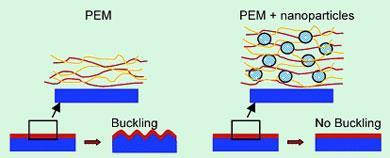A technique that stops thin polymer films wrinkling could stop similar effects in ageing skin.
Those of us unhappy with our ageing skin may find solace in nanotechnology. Researchers who have discovered that nanoparticles prevent thin polymer films from buckling say their concept could be applied to stop human skin wrinkling too.
Nanoparticles are already marketed in cosmetic skin products; usually because they can penetrate much deeper into skin than conventional creams, delivering vitamins that are supposed to plump and soften the skin, reducing wrinkling. The approach of Ilsoon Lee, of Michigan State University, US, is somewhat different: nanoparticles in sufficient concentration, he suggests, may stop the skin ever wrinkling in the first place.
That’s because the same underlying principles of wrinkling lie behind human skin and the polymer film systems which Lee has been investigating. Human skin, Lee says, consists of a thinner outer layer (the epidermis, around 50-100 ?m thick) resting on top of a thicker layer (the dermis, around 1-3 mm thick). Similarly, thin polymer films used to create anticorrosion, water-repelling, or biocompatible surfaces, and also in electronic devices like thin film transistor (TFT) screens, are formed on top of a thicker substrate - a flexible plastic, for example.

Although skin is a living material, vastly more complicated than a polymer film, Lee believes that both heated film and aged skin wrinkle permanently because they stiffen up more than the soft plastic or dermis below them. The same effect is seen in dried fruits, when thin dried skin stiffens over a soft interior.
Lee and his colleague Troy Hendricks wanted to prevent polymer films from buckling as they were compressed or heated during the manufacturing process. Wrinkled films, Lee told Chemistry World, can be a problem for electronic applications; for instance, the wrinkles can approach the size of the increasingly small features printed on the film, disrupting an electronic device’s function.
The researchers found that 50 nm silica particles deposited in layers through a thin polyelectrolyte film stopped the film from wrinkling up when heated or compressed. Lee suggests that the particles work by redistributing stress forces out of the plane of the film. The nanoparticles might affect the film’s performance, Lee conceded; though in the case he tried, the film stayed transparent to light as required. His group are testing different sorts of nanoparticles, of varying size and shape, to see if they have the same anti-wrinkling properties.
In themselves, said Geoffrey Ozin of the University of Toronto, California, US, these results are ’extremely interesting and scientifically surprising’. But Lee thinks that the same principles could be applied in a cosmetic product or implantable device to stop skin wrinkling too.
’We don’t mean that people will literally bombard their skin with nanoparticles,’ Lee told Chemistry World (though he pointed out that injecting a toxin, Botox, into one’s skin to remove wrinkles also sounds strange). Instead, he speculates that wrinkle-free film could be sandwiched between protecting layers, to be used in artificial skins for surgery, or implanted onto a face. Another route involves a topical cream containing materials which act in human skin as the nanoparticles behave in thin films.
There are obvious health and safety issues with such applications - the nanoparticles will have to be cleared for toxicity. Nor may Lee’s technique be generally applicable, if skin doesn’t behave in the same way as thin films do. But it’s an intriguing possibility: one more cosmetic spin-off to add to nanotech’s lengthening list.
Richard Van Noorden
References
T Hendricks and I Lee, Nano Letters, 2006, doi:10.1021/nl062544q






No comments yet